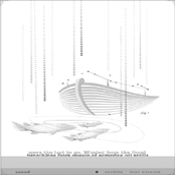webwork 1
ABOUT THE OTHER ANIMALS,
A poem by Ariana-Sophia KARSONIS, illustrated by Julie POTVIN, with music by Philippe GULLY, 2003
 Karonis's poem About the Other Animals presents itself as a re-reading of the Biblical Flood in which Noah vainly promises the "other animals" - those not taken onto the ark - to come back for them. The poem proposes a rather opaque allegory of disturbing beauty. Then the subtext emerges: the forgotten animals are compared to Penelope, to Ariadne, to Noah's anonymous wife ("Noah of the nameless wife"), and the tale of the Flood gives way to another, to that of the Garden of Eden:
Karonis's poem About the Other Animals presents itself as a re-reading of the Biblical Flood in which Noah vainly promises the "other animals" - those not taken onto the ark - to come back for them. The poem proposes a rather opaque allegory of disturbing beauty. Then the subtext emerges: the forgotten animals are compared to Penelope, to Ariadne, to Noah's anonymous wife ("Noah of the nameless wife"), and the tale of the Flood gives way to another, to that of the Garden of Eden:
So many wives'
tales later, rotten apples, borrowed
ribs, snakes in trees, gaps
in the telling and retelling
and untelling.
The meaning is thus revealed: the "other animals" are kin to the great forsaken women of mythological and Biblical narratives: the proverbially patient Penelope, weaving her cloth while awaiting Ulysses; Ariadne, whom Theseus used then abandoned on the Island of Naxos; Noah's nameless wife and daughters-in-law1; Eve and other Pandoras to whom a male religious imagination ascribes the origin of evil. The poem is an homage to the otherness and integrity of all absent creatures, those who preferred to refuse their passage rather than beg to be saved:
These refined beasts were in no hurry to catch the fleeing ark.
The lost creatures denied
their passage.
Always other, always animal.
Julie Potvin's animation supports the oppositions implied by the text - human/animal, male/female, same/other, earth/sea - by dividing the screen in two. The lower part, blue and almost imperceptible at first, gradually invades the white part above like a tidal flood. Scrolling along the surface, a verse at a time, the words of the poem are ultimately submerged. The splendid visual compositions sometimes seem to illustrate the poem (one recognizes the ark, the waves of a hurricane, a variegated bestiary), other times to anticipate it (even before the last stanza's direct allusion to the Garden of Eden, a duck-headed snake leads the reader to the Biblical myth as it accompanies the line "Others claim the beasts were to blame"), at others still, it opens the text to other meanings (strange drops of rain that become stars, longitudinal points, bubbles of air).
On distorted, scattered noises - perceptible among them, thunder and the patter of rain -, Philippe Gully's soundtrack superposes a melodic, minimal structure, insistent and repetitive, that constantly devolves into itself instead of evolving to a new phase or exploding into catharsis. When the lower screen finally engulfs the words and the animation stops, the soundtrack dwindles to the sole noise of dripping water. One thinks for a moment that the flood has finally swallowed everything, words, images, and notes, but the music soon starts up again, figuring for the meditative reader the distant echo of the other two voices, women's, that had become silent.
It's hard to describe the quality of the whole work and its successful integration of media without falling into cliché. Suffice it to say, if it isn't too general, that all facets of the work, the poem included, would lose if set on their own and benefit from their union. In a sense, we are miles away from the reader's promised freedom that the first writers and theoreticians of hypertext announced almost 15 years ago. Reading hypermedia work is in fact a rather constrained exercise: we have only limited control over the scrolling of lines, Gully's music sets the tone, and Potvin's visual compositions condition our interpretation. But the reader doesn't feel the constraint in an arrangement that enriches his or her experience, and willingly forgoes control, momentarily, to wander through About the Other Animals and other immersive media works - the ocean's lovely, and the level's rising.

Note
1: In the Biblical narrative (Genesis 6.10, 18; 7.7, 13; 8.1, 15-16, 18), only Noah's sons, Shem, Ham and Japheth are named, their wives being designated simply as such, their wives. 
Samuel Archibald

 top top
 back back
|

